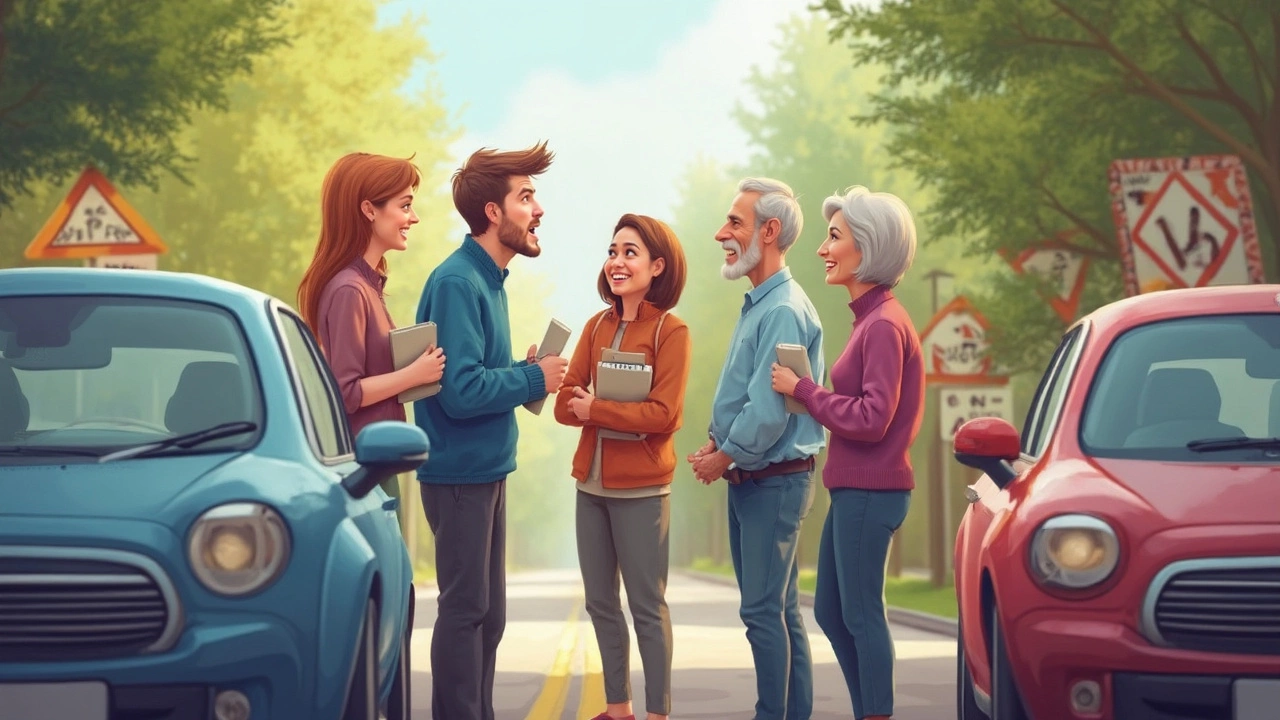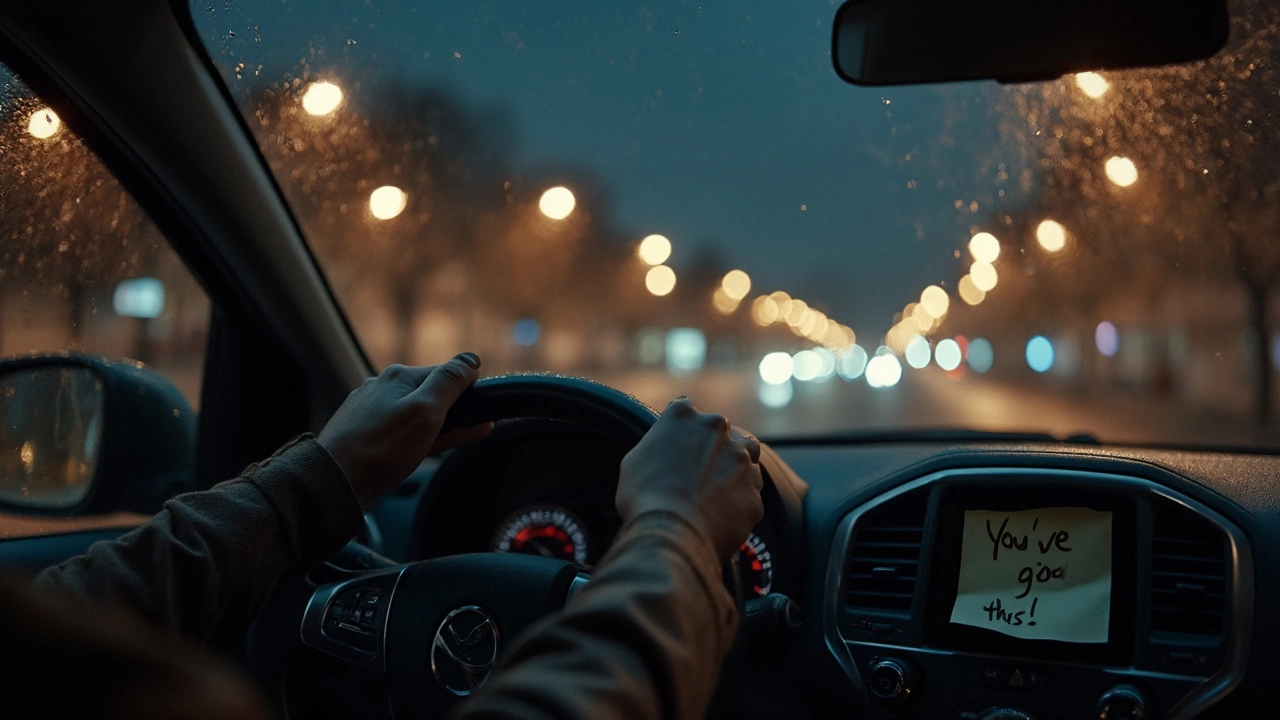Nerves can hit hard when you sit behind the wheel, whether you're a first-timer or someone who hasn't driven in a while. You're not weird for feeling your heart race at a red light or gripping the wheel on the highway—plenty of people are in the same boat. So, what can actually help you calm down before you even turn on the ignition?
First thing: don't reach for anything sketchy like untested herbal pills or your friend’s anxiety meds. Most of those “quick fixes” can mess up your focus or get you into trouble if you're pulled over. There are proven, safer ways to give your nerves a break. Start with steady, deep breathing. Sounds simple, but a few slow inhales and exhales can lower your stress and help your body relax almost right away.
It's also smart to set up your car in a way that makes you comfortable. Adjust the seat, mirrors, and temperature before you go anywhere. Play some music you like, but nothing too wild or loud that could distract you. The main thing is to make the space feel as safe and familiar as your living room.
- Why Driving Makes Us Anxious
- Tried-and-True Calming Techniques
- Foods, Drinks, and Supplements: What’s Safe?
- The Power of Practice and Preparation
- When to Seek More Help
Why Driving Makes Us Anxious
Driving can mess with your nerves for all kinds of reasons. For a lot of people, it’s not even about driving itself—it’s the stuff around it. Maybe you’ve had a bad experience in the past, or you’re worried about making a mistake in traffic. Even hearing stories about car accidents can stick with you, making your brain go straight to “worst case scenario” mode next time you grab your keys. Turns out, feeling anxious about driving is super common. A survey from the UK’s RAC Foundation found nearly 1 in 7 drivers admit to feeling anxious behind the wheel at least once a week.
Some common triggers crank up those nerves:
- Heavy traffic or rush hour jams
- Bad weather, like rain, snow, or fog
- Navigating new roads or unfamiliar routes
- Driving at night
- Feeling rushed or running late
There’s a science angle here too. When you’re in the car and your brain thinks you might mess up—or that you’re not safe—your body fires off stress hormones like adrenaline. That’s the same stuff that pumps through you if you almost drop your phone or hear a really loud noise. Your heart beats faster, your muscles tense, and you start to sweat. Suddenly, staying calm is ten times harder.
Getting to the bottom of what rattles your nerves is half the battle. Check out this quick table showing some reasons people feel anxiety while driving and how common each one is:
| Common Triggers | Percent of Drivers Affected |
|---|---|
| Driving in bad weather | 54% |
| Heavy traffic | 40% |
| Unfamiliar roads | 32% |
| Night driving | 25% |
| Fear of accidents | 21% |
The important thing to remember: you’re not strange for getting worked up. Anyone can feel anxious in a car—and it’s usually a reaction to something very real. Understanding the “why” is step one to finding what works to calm nerves driving and make trips less stressful.
Tried-and-True Calming Techniques
If you’re searching for ways to calm nerves driving, it’s not about finding secret tricks—just stuff that actually works. Here’s what tons of nervous drivers (including me, especially after Miranda pointed out my white knuckles) swear by.
- Breathing exercises: The 4-7-8 method is super popular. Breathe in for 4 seconds, hold for 7, and exhale for 8. It sends a signal to your brain to chill out. Experts say you don’t even need to close your eyes—keep them on the road!
- Grounding with your senses: Notice five things you see, four things you can touch, three you can hear, two you can smell, and one you can taste. It takes your mind off the nerves and gets you focused on the present.
- Progressive muscle relaxation: While stopped, tense up your shoulders, then let them drop. Move through your hands, arms, and jaw. This helps burn off that wound-up feeling.
- Positive talk: Replace “What if something goes wrong?” with “I’ve handled stuff like this before.” It might feel awkward at first, but your brain listens.
- Parking breaks: If you need it, pull over safely and step out. A 5-minute break can do wonders, even on busy days.
Studies from the AAA Foundation for Traffic Safety show regular deep breathing can lower your heart rate by up to 10 beats per minute during stress. That’s real proof, not just good vibes.
| Technique | Reported Relief |
|---|---|
| Breathing exercises | 73% |
| Grounding with senses | 65% |
| Progressive muscle relaxation | 59% |
| Positive talk | 56% |
| Parking breaks | 68% |
One extra thing: set your GPS and know your route before you go. Stress spikes when you feel lost. If technology fails, don’t panic—having a paper map as backup beats sweating through another wrong turn.

Foods, Drinks, and Supplements: What’s Safe?
Can what you eat or drink actually help when your nerves kick in before driving? Let’s get real—there’s no magic snack that wipes away anxiety for good, but some choices are way better than others. The main thing is picking options that boost your focus, not ones that might make your anxiety worse or put you at risk on the road.
Stay away from things like energy drinks or strong coffee if you’re prone to nerves. Too much caffeine can make your heart race and your hands shaky, which is the last thing you want behind the wheel. Instead, go for drinks like water or even herbal tea (think chamomile or peppermint). They keep you hydrated and can help settle your stomach without any buzz or crash.
If you need a little food before a drive, simple carbohydrates are your friend—think whole grain toast or a banana. These foods release energy slowly, so your blood sugar stays steady and you won’t get jittery. It’s good to avoid greasy, heavy foods; they make you feel tired and sluggish instead of sharp and alert.
What about supplements? There’s a lot of talk about things like CBD and calming vitamins. The truth: plenty of these aren’t well-studied for driving, and some could mess with your reaction time. Even supplements like valerian or melatonin come with warnings about drowsiness—definitely not what you want before you hit the gas. Always ask your doctor before you try anything new, especially if it could affect your ability to drive.
Here’s a quick look at how some common foods, drinks, and supplements stack up when it comes to staying calm and focused behind the wheel:
| Option | Good for Nerves? | Safe for Driving? | Notes |
|---|---|---|---|
| Chamomile Tea | Yes | Yes | Mildly calming, non-drowsy |
| Banana | Yes | Yes | Steady energy, easy to digest |
| Coffee | Depends | Yes/No | Okay in small amounts, skip if you’re jittery |
| CBD Supplements | Maybe | No* | *Not enough research for safe driving, can cause drowsiness |
| Valerian Root | Yes | No | Can make you drowsy, not safe before driving |
| Energy Drinks | No | No | Can spike anxiety and cause crash later |
| Water | Neutral | Yes | Stay hydrated, focus better |
Keep it simple: a light snack, water, and maybe some herbal tea will set you up way better than anything from the supplement aisle. If you’re wondering about something that’s not on this list, better play it safe and check with a doctor first. The whole point is to support your calm nerves driving, not gamble with your safety or the safety of others.
The Power of Practice and Preparation
If you're looking to calm nerves driving, there’s nothing more effective than good old practice. Anxiety often comes from not knowing what to expect. The more time you spend behind the wheel, the more these nerves start to chill out. Practice lets your body and brain get used to the motions: steering, checking mirrors, judging gaps, and reacting to what’s around you.
One study from the AAA Foundation found new drivers reduce their crash risk by almost half after their first 1,000 miles. That’s not about luck—that’s about practice grinding away at the stress until things get automatic.
If you’re prepping for tough situations, don’t just practice when conditions are perfect. Try driving in light rain, at dusk, or when traffic is moderate. Start slow by repeating familiar routes, then add short stretches of new roads as you build up confidence.
- Pick quiet times for driving practice, like Sunday mornings or early afternoons.
- Get a trusted friend or instructor to ride along. Sometimes, a calm voice in the passenger seat can remind you when you’re doing things right.
- Break down longer trips into smaller steps. Drive a few blocks, then take a breather. Add distance as you feel ready.
- Before heading out, walk through what you’ll do if something stressful pops up (like someone tailgating). Visualizing solutions prepares your mind to handle the real thing.
- Keep a small checklist in your car. Sometimes just having a routine before driving—seatbelt, mirrors, seat position, playlist—puts your brain in calm mode.
Being prepared goes beyond just steering. Knowing your route helps a ton. Plug your route into a navigation app, check for possible traffic jams, and get familiar with the turns. If you hate busy intersections, is there a way to go around them? A few minutes spent planning can save you a world of stress.
Here’s a quick look at how regular practice affects driving nerves over time:
| Weeks of Regular Driving | % of Drivers Reporting Nerves Drop |
|---|---|
| 1 week | 18% |
| 2 weeks | 35% |
| 4 weeks | 61% |
| 8+ weeks | 85% |
Small, regular practice really does add up. And the best part? You never have to white-knuckle the journey alone—preparation and practice build real confidence, not just the fake-it-till-you-make-it kind.

When to Seek More Help
If you’ve tried all the usual tricks—deep breathing, relaxing playlists, and setting up your car for comfort—but your nerves still hijack every drive, it might be time to talk to someone. There’s nothing weak about needing outside help. Driving anxiety can get so bad it turns into a real phobia called amaxophobia. Some folks avoid driving for years and miss out on jobs, trips, or even driving family around just because their fear is so strong.
Here’s what to watch for: if your anxiety about driving makes you feel panicked before every trip, causes full-blown panic attacks while you’re on the road, or leads you to avoid driving altogether, that’s a sign it’s beyond basic nerves. You could also notice physical symptoms—like sweating, dizziness, chest tightness, or feeling like you just can’t breathe—that show up every single time you’re behind the wheel.
Getting help doesn’t always mean meds, either. A lot of people improve with therapy, especially something called cognitive behavioral therapy (CBT). Research shows CBT can reduce driving anxiety more than most other treatments, and it’s usually short-term. Some therapists even offer ‘exposure therapy’, where you work through your fears step by step—with support.
- Therapists can teach you practical coping skills personalized for your anxiety.
- Support groups, online or in person, are great places to swap tips and feel less alone.
- Doctors can check if there’s another health issue, like a heart or thyroid problem, making your anxiety worse.
Don’t try to power through extreme nerves by yourself. When anxiety gets in the way of your freedom, relationships, or daily life, it's time for backup. Addressing calm nerves driving isn’t just about being brave—sometimes it’s about getting the right help so you don’t miss out on life—or the open road.

